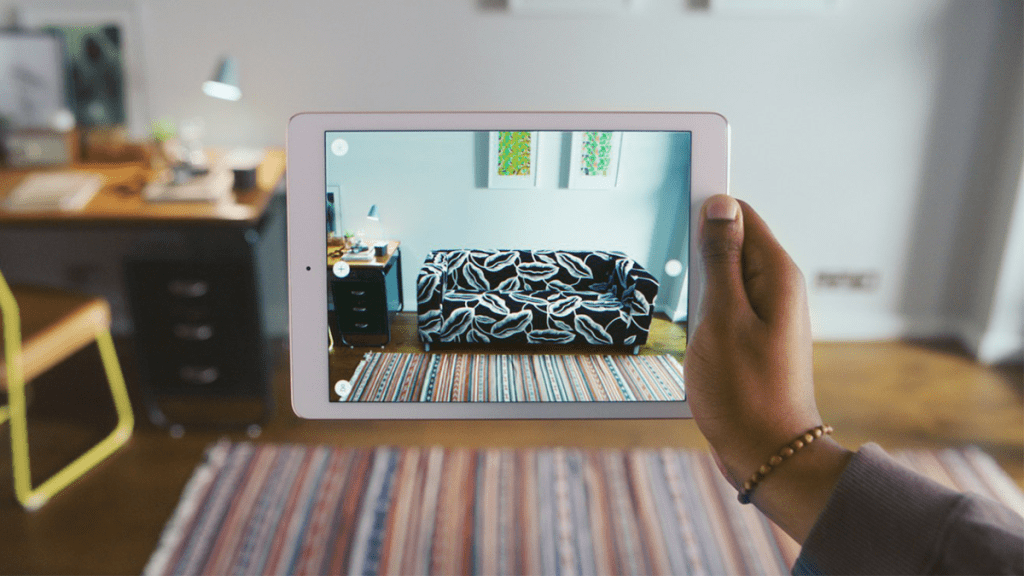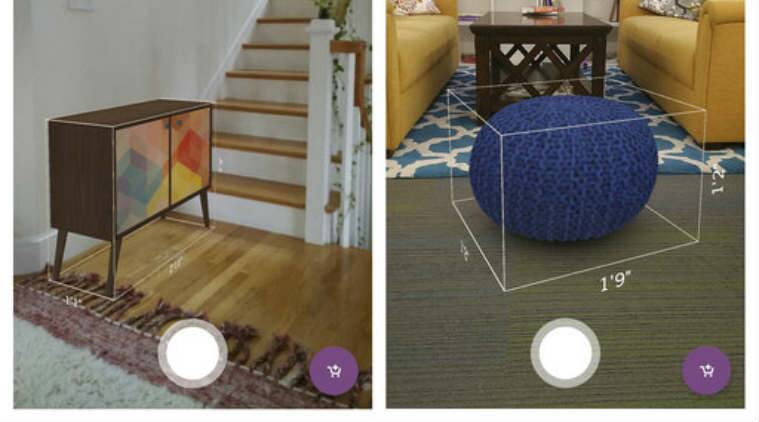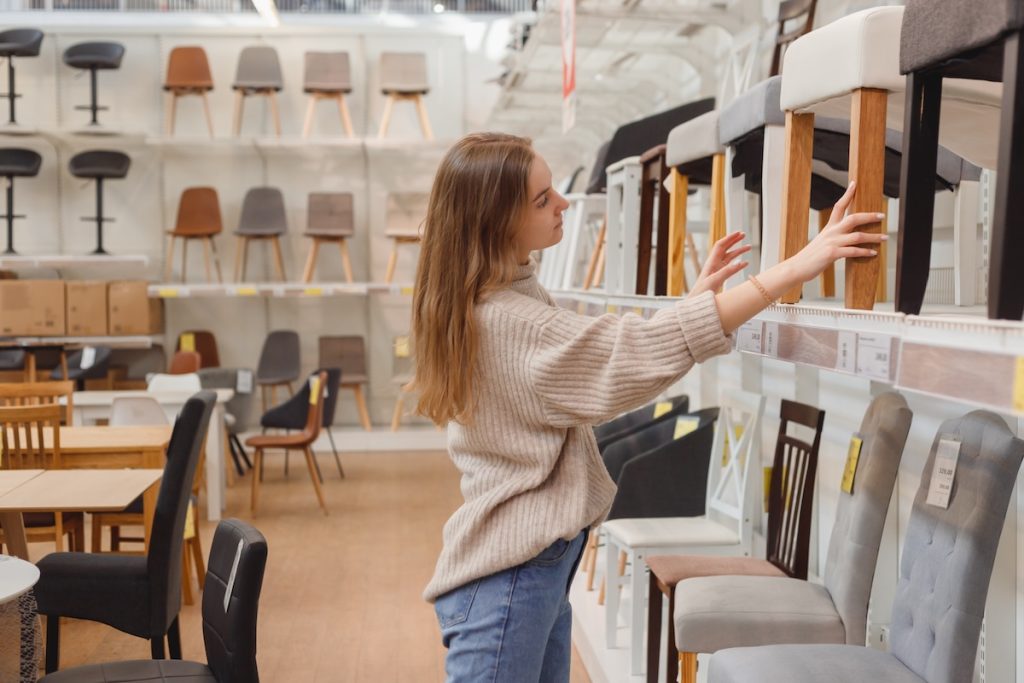Who can disagree that Augmented Reality has made modern-day shopping more exciting?
AR has contributed a lot of value to a customer’s sales journey because it’s the closest thing to an in-store purchasing experience that can be had from the comfort of one’s own home.
By 2020, 32% of shoppers were utilizing augmented reality while shopping.
AR offers a one-of-a-kind opportunity to engage customers and focus them on your product’s selling factors.
Every opportunity to engage a consumer comes with the risk of lowering the customer’s overall satisfaction. In 2022, augmented reality will assist high-intent shoppers in making informed online purchases, removing the need for them to visit a physical store.
What opportunities lie in omnichannel AR retail strategy?
Let’s take IKEA for example for understanding how your business can adopt an omnichannel AR retail strategy…

IKEA is an excellent example to think about here because it allows you to digitally place 3D models in your own home.
With AR and IKEA’s smart home solutions, you can now enjoy furniture assembly and customization like never before.
You can use your camera to select the ideal product or just one tap to arrange a room.
The amount of detail and information that AR can deliver is enormous.
By personalizing the buying process around omnichannel AR, it can blur the lines between deliberation and decision-making by teaching, informing, and establishing an innate demand for the goods.
Magic mirrors are one of the first things that come to mind when it comes to in-store augmented reality features.
While increasing shop visits is vital for retailers, ensuring that customers are actually engaged while in the store is critical for translating footfall into revenue.

Augmented reality retail solutions, according to our own research on brand engagement, give super-charged dwell times, engaging users for 10 times longer than traditional channels.
According to studies, 68 percent of buyers would spend more time at a retailer if they could shop with augmented reality, thus bringing the technology into stores is a fantastic method to keep customers browsing (and engaged) for longer.
For clothes retailers, this is ideal. Individuals enjoy immersing themselves in augmented reality experiences, and most by passers haven’t had the opportunity to do so.
Any omnichannel approach should be centered on the customer. Omnichannel AR allows you to showcase your company as a customer-centric company.
Let’s pretend you’re the owner of an electronics business. Given how many people nowadays buy technology online, would it be a good idea to send an undecided consumer home from your physical store to reconsider their purchase without completing the transaction? Absolutely!
What your store could do differently is send them home with an augmented reality marker or booklet that, when scanned, retrieves a 3D model of the considered product with all pertinent information, as well as the option of placing it in a customer’s house.
You are helpful, and you create trust by providing vital information to a bewildered buyer in this manner. You can’t make them buy from you, but if they do, they’ll most likely buy from you because of the extra effort you’ve put in.
Customers recognize and appreciate the time and effort you put into developing the technology that supports their experience, and they will thank you by purchasing something.
According to a global poll, omnichannel AR is the most popular technology for assisting, amplifying, and augmenting customers’ daily lives.
The same 51% of people stated they would be willing to utilize this technology to evaluate things before purchasing them.
The poll results are a wake-up call for small, medium, and large retail firms to efficiently use augmented reality technology to attract more customers and provide a fun and easy shopping experience.
When it comes to the FMCG industry, AR packaging provides a place to store additional information such as recipes, instructions, prizes, and more.
Extra material can also be based on amusement, and we like how businesses are incorporating AR games into children’s cereal boxes.
Numerous businesses are using augmented reality packaging to deliver remarkable stories. Nonetheless, the goal should always be to deliver value and include content that educates, explains, inspires, or entertains.
If you want to improve sales, you’ll need to successfully communicate about the AR experience in-store, but the content must still be worth your customers’ time. And if that’s the case, word will spread organically, outpacing any creativity in a store.
Need more insights?
Take a look at some intriguing data from 2020-2021 that illustrate how Augmented Reality technology has grown in popularity:
- AR/VR spending reached $18.8 billion globally
- AR apps are used by 1 billion people
- Advertisers are aware that AR sells, as 67 percent of ad firms employ it
- AR increases conversion rates by 40% for businesses.
- For the sales phase, 16% of shops employ omnichannel AR
In terms of consumers,
By 2022, more than 150 million people will have used augmented reality to purchase.
40% of customers said they would pay more for a product that they could modify using augmented reality.
Consumers favor retailers that offer augmented reality experiences, according to 61% of respondents.
Seventy-one percent of consumers believe they would purchase more frequently if they could use augmented reality.
It demonstrates that customers and retailers are progressing in their adoption of augmented reality technology in everyday life.
What opportunities lie in store for retailers using AR?
There has been an explosion of retailers who have found success in expanding their online retail businesses in the previous five years.
As merchants work to create a seamless experience across online and offline channels, Augmented Reality has become increasingly important in drawing customers across the board.
With Flipkart’s new 3D shopping tool, customers can use Augmented Reality on their smartphone to envision furniture in their own house.
The e-commerce behemoth is making it easier for customers to browse for a new sofa or center table by utilizing Augmented Reality to show them where they can put the furniture and how it will look in their house.
- Visualize product features
Before a consumer can proceed with their purchase, they must understand and comprehend how the product works and performs in order to make an informed decision.
Customers have been educated and product queries have been resolved as a result of retail merchants creating demos or instructional films.
This notion is taken a step further with Augmented Reality, which uses breathtaking, life-like 3D holograms to bring a product to life in front of the customer’s eyes.
Magic Mirror is an excellent augmented reality shopping experience that makes use of a camera and a mirrored television screen.
Using augmented reality software, it generates a virtual fitting room. The screen acts as a digital mirror, reflecting the user while displaying video feeds from various angles.
The customer has a variety of cosmetics, purses, headgear, and jewelry to try on.
It allows children to quickly switch and try on different colors of an outfit. It enables shoppers to swiftly locate the things that best meet their needs and make quick purchasing selections.
- More interactions during purchasing
Although internet shopping provides a unique experience for customers by allowing them to examine a variety of styles in various sizes, colors, and shapes in one place, it does not provide an interactive buying process.
Augmented Reality (AR) efficiently bridges this gap.
In only a few simple steps, a consumer can,
- Get the AR app from the Google Play Store.
- Open the app and look through the public gallery for 3D models of products, homes, and technology.
- When you select a product, the app activates the camera to locate a suitable surface for it.
- The program places the chosen item on the desired surface.
- Users get a 360-degree glimpse and feel of the object without really holding it.
Sephora Virtual Artist, an Augmented Reality tool, enables shoppers to try on thousands of lipstick colors, eyeshadow, false lashes, and various other makeup products.
It also allows users to see beauty instructions on their faces in order to learn how to achieve particular looks.
Color Match, another intriguing feature, uses Artificial Intelligence to help consumers identify the best color hue for their skin tone based on an uploaded photo.
Customers have been hesitant to shop online for specific categories of products, such as make up, despite the fact that coming to a store has proved overwhelming.
Thanks to augmented reality, they can confidently shop for their favorite hues from the comfort of their own homes.
3. Lower return rates
Businesses do not want their inventory to be returned to the warehouse.
Returns, on the other hand, are practically hard to prevent in a retail channel that does not allow customers to sample before they buy.
According to research, 30% of ordered products are returned online, compared to 8.89% in brick-and-mortar businesses.
Top reasons why consumers returned their products in 2021:
- 23% of people got the wrong goods.
- 22% received products that were unusual in appearance.
- 20% of the products received were faulty.
By providing an engaging, life-like “try-before-you-buy” digital experience, omnichannel AR helps retailers and merchants drastically reduce the 22 percent of returns of products that seem different.
The 3D renderings allow customers to examine how products look and feel before committing to a purchase, decreasing the need to order many items in order to find the appropriate product.
It greatly aids in the reduction of product returns in e-commerce.
4. After sales support using AR
Customer service is heavily reliant on human interaction. When looking at products, making a purchase, or filing a complaint, many individuals prefer to chat with a live person. As a result, the training you provide your service agents is crucial.
AR has the potential to make training more effective and efficient. Take, for example, a company that sells a variety of goods. Its customer service representatives must be able to describe each item to potential customers in detail. It’s not enough to have a rudimentary understanding of product lines.
Hands-on experience is the only method for employees to achieve that level of skill. AR apps can provide that experience without requiring a staff person to physically touch each item. AR models can be used to simulate a real product, allowing you to train your employees in a fraction of the time.
Lowe’s, a home improvement shop, is an example of a company that has used AR in this fashion. Lowe’s 3D AR software develops high-fidelity 3D models that allow users to digitally explore and experience the company’s merchandise. The app is used not only to teach employees, but it is also offered to customers who wish to try out features before purchasing them.
Hands-on experience is the only method for employees to achieve that level of skill. AR apps can provide that experience without requiring a staff person to physically touch each item. AR models can be used to simulate a real product, allowing you to train your employees in a fraction of the time.
Lowe’s, a home improvement shop, is an example of a company that has used AR in this fashion. Lowe’s 3D AR software develops high-fidelity 3D models that allow users to digitally explore and experience the company’s merchandise.
The app is used not only to teach employees, but it is also offered to customers who wish to try out features before purchasing them.

What solutions can be offered by Kilowott via omnichannel AR retail strategies?
The introduction of Augmented Reality technology has changed the way businesses think about their omnichannel operations.
Kilowott’s omnichannel retail solutions enable retailers to satisfy the bottom line of their omnichannel strategy while also improving the customer experience.
It also boosts conversion rates and lowers product returns by a large margin.
Retailers may enhance word-of-mouth marketing for their retail brand by providing a unique and memorable experience for their customers.
Kilowott can build an omnichannel AR software that can also be used by retailers to promote bargains and special deals, encouraging customers to try new products and generating new sales leads.
Explore how you can use Augmented Reality to give your consumers an immersive AR experience in your retail business leagues ahead of the competition.
Connect with us to learn about how Kilowott can build your business a platform that can help your company provide a seamless try-on experience. We can help you reach out and engage your customer through all touch points. Let’s talk AR for retail…






